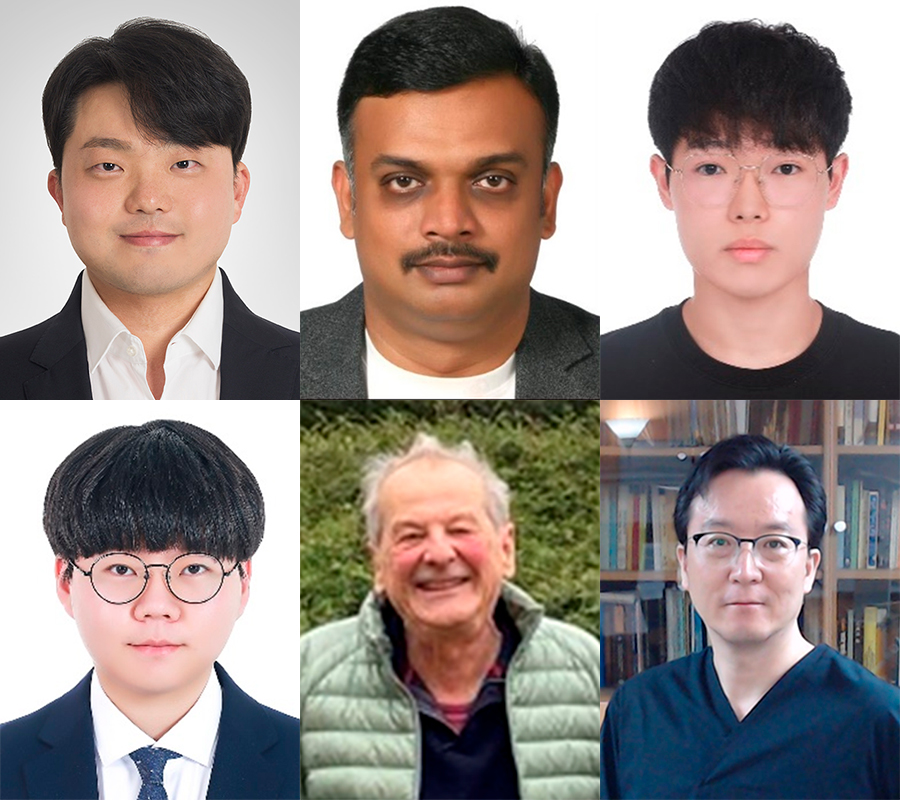학생실적
| 뇌종양 진단 국제공동연구 '주목' (International Collaborative Research on Brain Tumor Diagnosis 'Draws Attention') | |||
| 작성일 | 2025-04-01 | 조회수 | 311 |
|---|---|---|---|
| 첨부파일 | |||
|
국립부경대-부산대-프랑스 국립과학연구센터 국제공동연구, 나노포토닉스 뇌종양 진단 전략 제시 - 국립부경대 임해균 교수팀, 국제학술지
△ 연구팀 사진. (위 왼쪽부터) 임해균 교수, Badrinathan Sridharan 박사, 박진형 석사과정생 (아래 왼쪽부터) 김대훈 박사과정생, Jean?Claude Vial 교수, 김광석 교수.
국립부경대학교 스마트헬스케어학부 의공학전공 임해균 교수 연구팀이 나노포토닉스(nanophotonics) 기반의 광음향 뇌영상 기술(Photoacoustic Brain Imaging)을 활용한 뇌종양 진단 및 치료 전략을 제시해 주목받고 있다.
국립부경대 임해균 교수와 Badrinathan Sridharan 박사, 박진형 석사과정생, 김대훈 박사과정생, 부산대 김광석 교수(광메카트로닉스공학과), 프랑스 국립과학연구센터 Jean?Claude Vial 교수 등 국제공동연구팀은 총설 논문 ‘Nanophotonic-enhanced photoacoustic imaging for brain tumor detection’을 국제학술지
광음향 뇌영상 기술은 레이저 빛의 광학적 대비도와 초음파의 우수한 조직 침투라는 장점을 결합해 뇌 내부의 종양 및 신경혈관 구조를 비침습적이고 고해상도로 실시간 영상화할 수 있는 기술이다.
연구팀은 광음향 뇌영상 기술에 빛과 물질의 상호작용을 나노미터 수준에서 제어하는 기술인 나노포토닉스를 접목하고, 다양한 나노 소재(금 나노입자, 유기 나노입자 등)를 이용해 광음향 신호를 증폭시킴으로써 더욱 정밀한 뇌 조직 영상화를 실현하는 방법을 제시했다.
이와 함께 뇌종양 치료에 걸림돌이 되는 혈뇌장벽(BBB) 및 혈액-종양 장벽(BTB)과 같은 생리적 장벽을 효과적으로 극복해 뇌종양 치료를 위한 약물 전달 효율을 높이는 방법들도 밝혔다.
특히, 초음파 유도 하에 나노입자를 통해 혈뇌장벽을 일시적으로 개방하고, 이를 통해 약물이나 나노 소재가 뇌종양 부위로 정밀하고 효과적으로 전달될 수 있도록 하는 방법을 강조했다.
임해균 교수는 “광음향 뇌영상 기술이 기존 MRI, CT, PET 등 의료영상 기술과 융합해 뇌종양 진단 및 치료 모니터링의 정확성을 크게 향상하는 등 다양한 뇌 질환 치료 분야에서 혁신적인 발전을 이룰 수 있을 것을 기대한다.”라고 밝혔다.
한편, 이번 연구를 수행한 국제공동연구단(단장 김광석 교수)은 과학기술정보통신부의 지원을 받아 한국연구재단의 ‘브레인링크(BrainLink)’사업으로 운영되고 있으며, 다양한 유·무기·생체 나노소재를 기반으로 나노포토닉스 분야에서 국제적 경쟁력을 지닌 집단공동연구 네트워크를 구축해 공동연구를 진행 중이다. <부경투데이>
Pukyong National University, Pusan National University, and the French National Centre for Scientific Research Present International Collaborative Research on Nanophotonics Brain Tumor Diagnosis Strategy - Pukyong National University's Professor Lim Hae-kyun and the team publish review article in the international journal
A research team led by Professor Haekyun Lim of the Department of Medical Engineering at Pukyong National University's Smart Healthcare Department has attracted attention for presenting a brain tumor diagnosis and treatment strategy using nanophotonics-based photoacoustic brain imaging technology.
The international collaborative research team, including Professor Lim Hae-kyun of Pukyong National University, Dr. Badrinathan Sridharan, Master's student Park Jin-Hyung, Doctoral student Kim Dae-Hoon, Professor Kim Kwang-Seok from Pusan National University (Department of Photonics and Mechatronics Engineering), and Professor Jean-Claude Vial from the French National Centre for Scientific Research, published a review paper titled ‘Nanophotonic-enhanced photoacoustic imaging for brain tumor detection’ in the international journal
Photoacoustic brain imaging technology combines the optical contrast of laser light with the superior tissue penetration of ultrasound, enabling non-invasive, high-resolution real-time imaging of tumors and neurovascular structures within the brain.
The research team integrated nanophotonics, a technology that controls the interaction between light and matter at the nanometer scale, with photoacoustic brain imaging. By using various nanomaterials (such as gold nanoparticles and organic nanoparticles), they amplified the photoacoustic signal, presenting a method for achieving even more precise brain tissue imaging.
Additionally, the team proposed effective methods to overcome physiological barriers such as the blood-brain barrier (BBB) and blood-tumor barrier (BTB), which are obstacles to brain tumor treatment, thereby improving drug delivery efficiency for brain tumor therapy.
In particular, they highlighted a method where ultrasound is used to temporarily open the blood-brain barrier using nanoparticles, allowing drugs or nanomaterials to be precisely and effectively delivered to the brain tumor site.
Professor Lim Hae-kyun stated, "We expect that photoacoustic brain imaging technology, when integrated with existing medical imaging technologies like MRI, CT, and PET, will significantly improve the accuracy of brain tumor diagnosis and treatment monitoring, leading to innovative advancements in various brain disease treatments."
Meanwhile, the international research team (led by Professor Kim Gwang-seok) that conducted this study is operating under the 'BrainLink' project funded by the Ministry of Science and ICT and supported by the Korean Research Foundation. The team is building a collaborative research network with international competitiveness in the field of nanophotonics, based on various organic, inorganic, and bio-nanomaterials, and is currently conducting joint research. <관련링크> |
|||
| 다음 | 대한의용생체공학회 우수 논문상 수상 |
|---|---|
| 이전 | 강명지 석사과정생 최우수 논문상 활약 |
